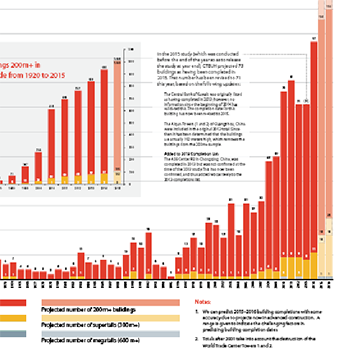Fortune Plaza
Beijing
- CTBUH Drawing
- Facts
-
Metrics
You must be a CTBUH Member to view this resource.
To Tip:
Height is measured from the level of the lowest, significant, open-air, pedestrian entrance to the highest point of the building, irrespective of material or function of the highest element (i.e., including antennae, flagpoles, signage and other functional-technical equipment).Architectural:
Height is measured from the level of the lowest, significant, open-air, pedestrian entrance to the architectural top of the building, including spires, but not including antennae, signage, flag poles or other functional-technical equipment. This measurement is the most widely utilized and is employed to define the Council on Tall Buildings and Urban Habitat (CTBUH) rankings of the "World's Tallest Buildings."Occupied:
Height is measured from the level of the lowest, significant, open-air, pedestrian entrance to the highest occupied floor within the building.
Above Ground
The number of floors above ground should include the ground floor level and be the number of main floors above ground, including any significant mezzanine floors and major mechanical plant floors. Mechanical mezzanines should not be included if they have a significantly smaller floor area than the major floors below. Similarly, mechanical penthouses or plant rooms protruding above the general roof area should not be counted. Note: CTBUH floor counts may differ from published accounts, as it is common in some regions of the world for certain floor levels not to be included (e.g., the level 4, 14, 24, etc. in Hong Kong).Below Ground
The number of floors below ground should include all major floors located below the ground floor level.Official Name
Fortune Plaza
Type
Complex
Status
Completed
Country
City
Function
hotel / office / residential
# of Hotel Rooms
521
# of Parking Spaces
296
Map of Buildings in Complex
Note: Only buildings that have GPS coordinates recorded are displayed.
List of Buildings in Complex
Please note that all heights shown in italics/red are estimated heights. These have been calculated based on known floor counts for the building, then extrapolated through analyzing typically hundreds of buildings of the same function on this database that do have confirmed heights. The user should be aware that non-standard building features, such as significant spires or raised entrances / podiums, may affect the accuracy of these estimations.
|
RANK
|
Name
|
Completion
|
Height
|
Floors
|
Function
|
|---|---|---|---|---|---|
| 1 | Fortune Financial Center | 2014 |
267 m / 876 ft |
60 | Office |
| 2 | Fortune Heights | 2008 |
199 m / 653 ft |
55 | Residential |
| 3 | Fortune Plaza Apartments II | - |
180 m / 591 ft |
N/A | Residential |
| 4 | Fortune Plaza Office Building II | 2006 |
166 m / 545 ft |
46 | Office |
| 5 | Fortune Plaza Apartments I | 2005 |
123 m / 404 ft |
40 | Residential |
| 6 | Grand Millennium Beijing | 2008 |
103 m / 338 ft
Please note that this height is estimated, based on a floor count of 27 floors. The estimation has been arrived at by analyzing 1,189 other buildings of the same Hotel function on this database that do have confirmed heights. The user should be aware that non-standard features, such as significant spires or raised entrances / podiums, may affect the accuracy of this estimation.
|
27 | Hotel |
CTBUH Initiatives
CTBUH Releases Year in Review: Tall Trends of 2014
31 December 2014 - CTBUH Journal
Research

31 December 2014
Interactive Study on Year in Review: Tall Trends of 2014
Daniel Safarik, Antony Wood, Marty Carver & Marshall Gerometta, CTBUH
An All-Time Record 97 Buildings of 200 Meters or Higher Completed in 2014 and 2014 showed further shifts towards Asia, and also surprising developments in...



